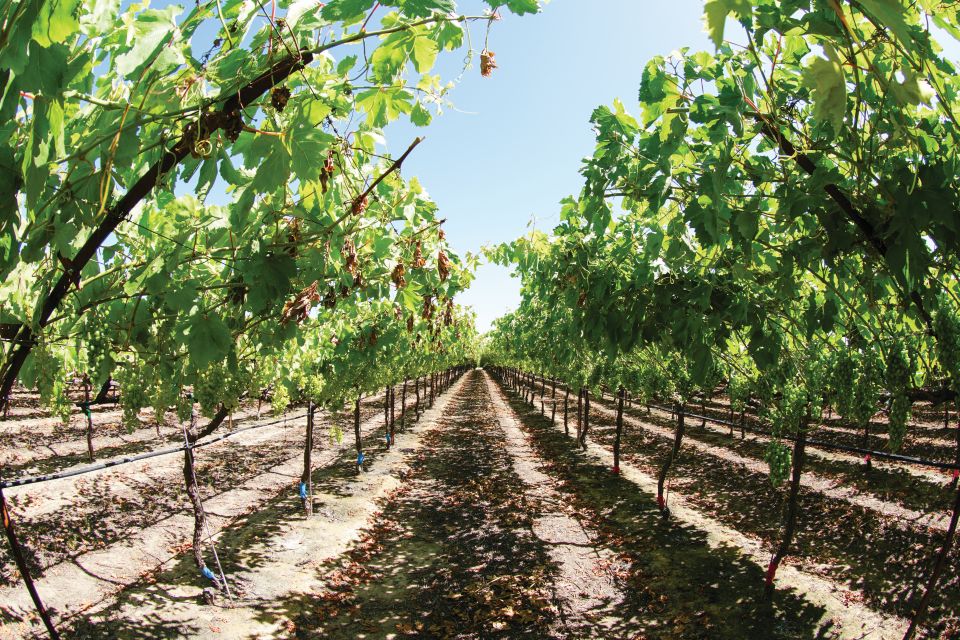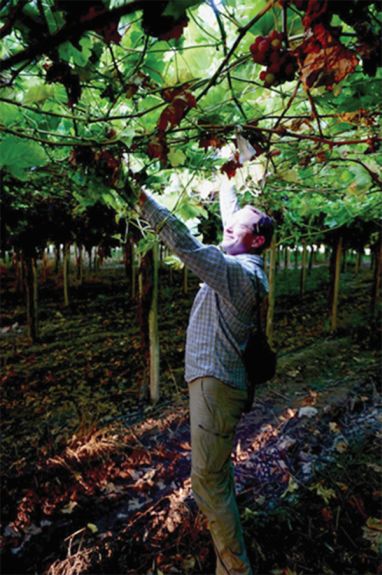Tips to Make the Most of Nitrogen Applications for Grapes

Vines on the left are severely N deficient, with light-colored leaves and sparse canopy. Vines on the right have a better N status, with dark colored leaves and a fuller canopy. (Photo: Matthew Fidelibus)
Grapevines have relatively low nitrogen (N) requirements compared to many other crops. Nevertheless, N is the nutrient that most often requires supplementation in the vineyards of California’s San Joaquin Valley (SJV). Although N fertilization can increase grape quality and yield, it may not do so if applied at the wrong time or in excess.
Therefore, it is important to ascertain whether the vines are likely to benefit from N supplementation or not and, if so, apply N at appropriate times and amounts. Such steps will help make the best use of this resource and minimize potential losses of N through denitrification, volatilization, or leaching.
Severe N deficiency is uncommonly observed in commercial vineyards of the SJV, but easily recognized. Leaves on such vines appear pale green to yellow-green, with smaller blades and shorter shoots. Vines with a less severe deficiency may have normal leaf color, but lower vigor than vines with moderate or high N status. Vines that sufficiently fill the trellis, without excessive shading, are likely of adequate N status.
Vines with high N status exhibit luxuriant growth of large, dark-green leaves on shoots with long internodes. Shoots may also be flattened in cross section, and have profuse lateral shoot growth. Too much N often reduces yields for a number of reasons including excessive shatter, waterberry, low bud fruitfulness, and higher susceptibility to Phomopsis, powdery mildew, and sour rot.

University of California Cooperative Extension Farm Advisor Mark Battany inspects a canopy of vines in Argentina that have been given too much nitrogen. The grower based his application on lab results only. (Photo: Matthew Fidelibus)
Getting a Read on N Status
Laboratory analysis can help confirm vine N status. Former University of California viticulture specialist L. Peter Christensen established critical NO3-N bloom time petiole values for ‘Thompson Seedless.’ For petioles collected opposite clusters at bloom, he considered NO3-N values less than 350 ppm to be deficient, 350 to 500 ppm questionable, 500 to 1,200 ppm adequate, 1,200 to 2,000 ppm more than necessary, and greater than 2,000 excessive.
However, petiole nitrate levels can vary widely among different grape varieties and rootstocks and may be further influenced by weather conditions. Therefore, these ranges should be used as supplemental information to help confirm observations on vine growth and canopy assessment. The sole reliance on petiole data can lead to poor management decisions.
Christensen advocated petiole sampling — collected at bloom, opposite clusters — for laboratory analyses because petiole samples can represent more individual shoots and vines as compared to blades since more petioles are needed to achieve the same amount of dry tissue as blades. Additionally, petioles are less prone to surface contamination and are easier to wash and dry.
Moreover, NO3 levels differ among organs, and more data from petioles than blades are available for comparison. Tissue N levels also vary according to phenology, which is why petioles should be collected at defined developmental periods such as at bloom. Bloom time tests also provide time for corrective fertilizer treatments to be made, if needed.
Management Tips
If visual assessment and laboratory analyses suggest N is needed, vineyard cultural requirements, all possible sources of N, soil chemistry, and root and vine conditions should be considered as part of the N management plan. Winter and early spring are poor times to apply N as vine demand is low, and the fertilizer easily leached.
One month after bud break and post fruit set are good times to apply N, as uptake and demand are high. Postharvest N application may be effective for early to mid-season varieties but could stimulate late season growth and retard cane maturity and thus is not recommended for late season varieties.
Replacing N removed in harvested fruit (approximately 3 pounds N per ton fruit) may be enough for vines of good N status, but monitor to track response; deficient vines will need more than replacement N.










